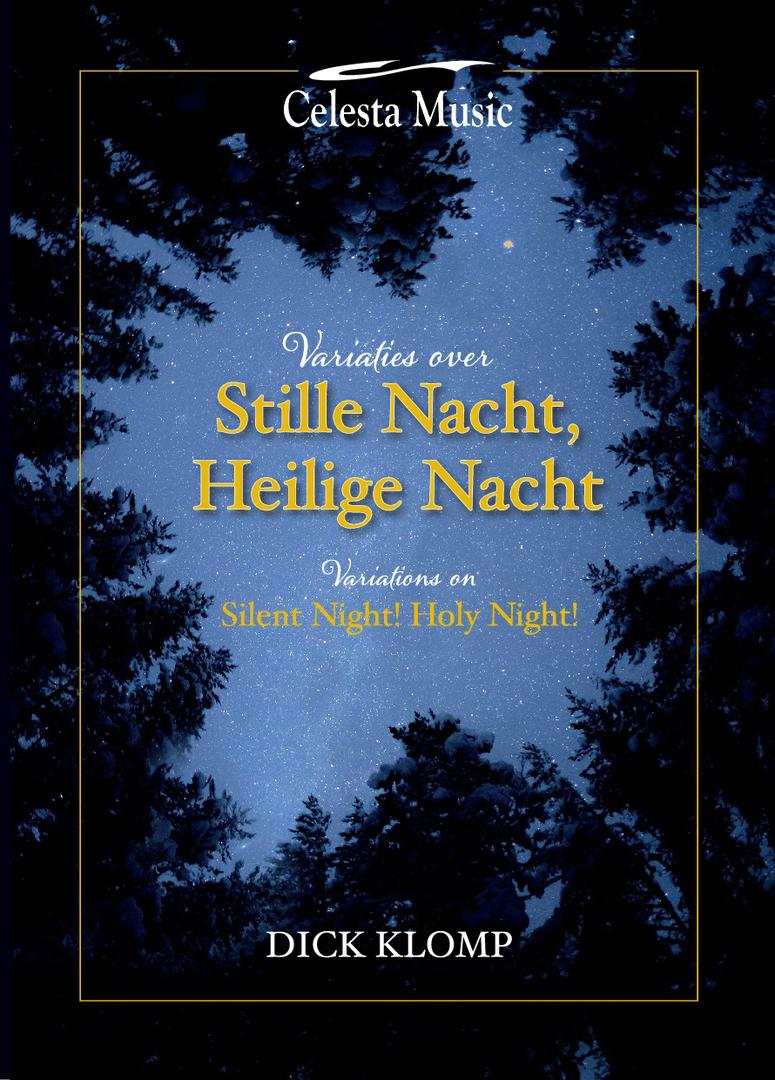Prachtige KERSTMUZIEK van de Amsterdamse organist DICK KLOMP.
Lees ook de recensie onderaan deze pagina!
Een prachtig drieluik over het bekendste kerstlied. Sfeervol, fijnzinnig, lyrisch, speels en origineel.
20 pagina's incl. cover.
Recensie door Bert den Hertog (concertorganist)
De Variaties over 'Stille Nacht, Heilige Nacht' is een verrassend stuk van de - mij tot voor kort onbekende - organist/componist Dick Klomp. Hij schreef het werk in 1977 voor het Rieger-orgel in de Abdij Marienstatt in Duitsland. De variaties zijn dan ook geschreven voor de mogelijkheden van dit grote orgel, maar zeker ook goed uitvoerbaar op elk orgel met behoorlijke mogelijkheden met tenminste twee klavieren en vrij pedaal.
De melodie van Stille Nacht heb ik altijd ervaren als problematisch in die zin dat enerzijds een al te creatieve omgang ermee vaak wat gekunsteld kan overkomen, en anderzijds een conservatieve behandeling een reuk van oubolligheid kan oproepen... Niets daarvan in Klomp's variaties. De eerste variatie is een parelend carillon voor de rechterhand (met fluiten 8',4', en 1'), waarbij de linkerhand eerst motieven uit de melodie laat horen, later tweestemmig de hele melodie tegen diens omkering. Minstens zo knap geschreven is de tweede variatie waarbij weer de linkerhand de hele melodie speelt, terwijl de rechterhand in 3/4 maat twee prachtige tegenstemmen speelt. De combinatie van 3/4 en 6/8 maat is overtuigend uitgewerkt, en zorgt voor een 'fascinerend' effect voor speler en luisteraar. Variatie 3 bestaat uit twee delen: in deel 1 is een imitatie te horen tussen twee fluiten, zeer vrij aan de melodie van Stille Nacht verwant, waarbij lange pedaal noten voor tonale stabiliteit zorgen; deel 2 is een echte sfeerbewerking voor de Voix Céleste in de linkerhand met akkoorden die een vroeg 20ste eeuwse Franse sfeer oproepen (denk aan Vierne, Alain en Langlais), terwijl pedaal en rechterhand in een vrij metrum motieven uit de melodie variëren. Dit deel roept zeer geslaagd een meditatieve, maar nooit saaie of te zoete sfeer op.
Het stuk is een grote aanwinst te noemen voor het kerstrepertoire, en zeer geschikt voor gebruik in de eredienst (variatie 1 en 3 bijvoorbeeld voor of na de dienst, of tijdens de collecte, variatie 2 als voorspel) of tijdens kerstconcerten. Het is te hopen dat Dick Klomp vaker van zich zal laten horen als componist!
Als laatste: de uitgave is niets minder dan voorbeeldig te noemen, met een tweetalig voorwoord (Nederlands en Engels) met informatie over de componist en adviezen over de uitvoering. Het notenbeeld is zeer duidelijk, en het is bijna overal mogelijk om zelf om te slaan. Warm aanbevolen!
Wilt u deze compositie bestellen?: Mail uw bestelling naar celestamusic@gmail.com
Dick Klomp speelt zijn eigen compositie op Youtube: https://www.youtube.com/watch?v=xBiG7HWNvZY )
Variations on 'Silent Night! Holy Night!
Composer: Dick Klomp
A beautiful triptych of the most famous Christmas carol. Atmospheric, subtle, lyrical, playful and original.
20 pages incl. cover.
(Translation by Google translate)
The Variations on 'Silent Night, Holy Night' is a surprising piece of - me until recently unknown - organist / composer Dick Klomp. He wrote the work in 1977 for the Rieger organ in the Abbey Marienstatt in Germany. The variations are also written for the potential of this great organ, but also feasible at any organ with decent features at least two manuals and pedal.
The melody of Silent Night I have always experienced as problematic in the sense that on the one hand an overly creative use it often may seem contrived, and the other a conservative treatment can evoke a smell of corny ... Nothing of them in Klomp's variations. The first variation is a pearling carillon for the right hand (with flutes 8 ', 4', and 1 '), the left first motivational sounds from the melody, later two voices throughout the melody against his reversal. At least written so clever is the second variation where again the left hand plays the whole melody, while the right hand plays two beautiful 3/4 vote against. The combination of 3/4 and 6/8 elaborated convincing, and provides a 'fascinating' effect for player and listener. Variation 3 consists of two parts: Part 1 is an imitation heard between two flutes, very quite to the melody of Silent Night related, which long pedal notes provide tonal stability; Part 2 is a real feel for the operation Voix Céleste in the left hand with chords that evoke an early 20th century French atmosphere (think Vierne, and Langlais Alain), while pedal and right vary in a fairly meter motifs from the melody. This part is very successful evokes a meditative, but never boring or too sweet atmosphere.
The piece is called a great asset to the Christmas repertoire, and very suitable for use in worship (variation 1 and 3, for example, before or after the service, or during the collection, variation 2 as foreplay) or during Christmas concerts. It is hoped that Dick Klomp will make more of themselves heard as a composer! Finally, the issue of Celesta Music can be called nothing less than exemplary, with a bilingual preface (Dutch and English) with information about the composer and advice on implementation. The notes are very clear, and it is almost always possible to turn the pages by yourself. Highly recommended!
Dick Klomp playing is own piece :
https://www.youtube.com/watch?v=xBiG7HWNvZY






